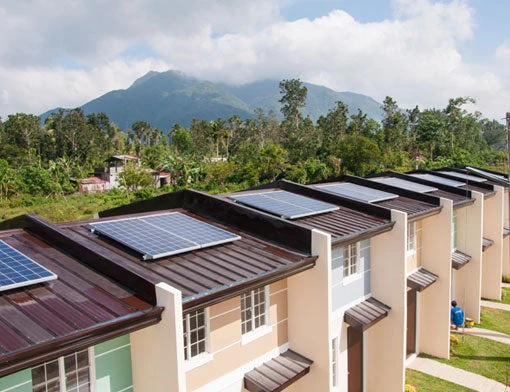
Buildings now dot the skyline of Bonifacio Global City in Metro Manila, which hosts, among others, the offices of the World Bank and the International Finance Corporation. Who would have thought that this former military camp could be transformed into a bustling economic center in less than ten years? And, with the rise of commercial buildings and residential condominiums following the area’s fast-paced growth, we see a growing demand for electricity that causes stress on the environment and resources.
The Fifth Assessment Report (2015) of the Intergovernmental Panel on Climate Change shows that commercial and residential buildings contribute about a quarter of the total global emission of greenhouse gases. In the Philippines, CO2 emission from electricity and heat production is about 36.6 million tonnes, according to data from the International Energy Agency in 2014.
In the Philippines, commercial and residential buildings are the biggest consumers of electricity. The Department of Energy says that in 2013, these used up 63% of electricity supply, totaling 38.92 Million Megawatt hour (MwH) This represents a 45% increase from ten years back, when their consumption was about 26.46 million Megawatt hour in 2003. With the annual building growth rate of 6%, and the way we are designing, constructing and maintaining buildings, we are putting extreme pressure on our electricity supply. In October 2014, the Department of Energy announced a bleak supply-demand outlook, with the thinning of net power reserves expected in March and April 2015.
Solutions to the problem are evident: reduce energy use and shift to clean or renewable energy. Start building green. Green buildings promote energy and resource efficiency while reducing the buildings’ impact on human health and the environment. However, there is a very low take up of green buildings by developers and the construction industry. And this is because of lack of awareness and many misconceptions about building green. Green buildings are perceived to be costly because of its complex technology and thus, affordable only to high-end developers and would-be occupants.
Green buildings don’t cost much. Energy-saving measures incorporated at the early stage of construction will not entail additional cost. Building orientation, window-to-wall ratio, access to natural air and light, choice of paint colors and other building techniques can be incorporated at the design stage. The proposed green building measures in the National Green Building Code (and which are undergoing public consultations) have high energy reduction potential either at no extra cost or with a payback period of not more than five years. Even at a cost, benefits return two-fold from savings resulting from reduced energy use.
Green buildings are not difficult to build. There is no need to go back to school to learn green technology. Developers and professionals should only be aware of what is available in the market. IFC developed the Excellence in Design for Greater Efficiencies (EDGE) tool. It is locally calibrated for the Philippines, based on baseline and market studies. The user-friendly tool, available in the IFC website , lists a number of green measures with corresponding reduction potential and costing. It provides a tool for computing the impact of green building measures on the consumption of energy, water, and materials. A 20% reduction in the use of each of these elements can earn an organization an EDGE certification in design and construction.
Green buildings don’t drive away consumers. With the high electricity rate in the Philippines, green buildings become attractive to occupants who want to save on energy cost. Multinational corporations, as part of their corporate social responsibility for climate change mitigation, choose to hold offices in green buildings. In addition, studies show that occupants of green buildings have improved productivity levels.
Green buildings are not just for large buildings. For the past few years, green buildings in the Philippines were the turf of big developers of high-end properties. Green building certifications such as the LEED or Leadership in Energy & Environmental Design are applicable to big properties of more than 15,000 gross floor areas. IFC’s EDGE tool complements the various certification systems in the market by extending the reach to other structures. The Tiarra Premiere Homes designed by Imperial Homes, Inc., is an example of green building for socialized housing. Tiarra, an attached two-story house with a total floor area of 36 square meters, incorporates green measures at minimal cost. It is the first recipient in the Philippines of the EDGE certification in design that will potentially reduce consumption of energy by 32%, water by 28%, and embodied energy in materials by 38%.
By designing buildings with improved resource efficiency, we lock in energy and water savings. IFC’s green building program in the Philippines contributes to this effort. The program is expected to reduce the country’s greenhouse gas emissions by 1.9 million metric tons of carbon dioxide, save 3.9 million kwh in energy and Php38 billion ($864 million ) annually by 2030.
Do you have green building practices in your household and in your community?


Join the Conversation